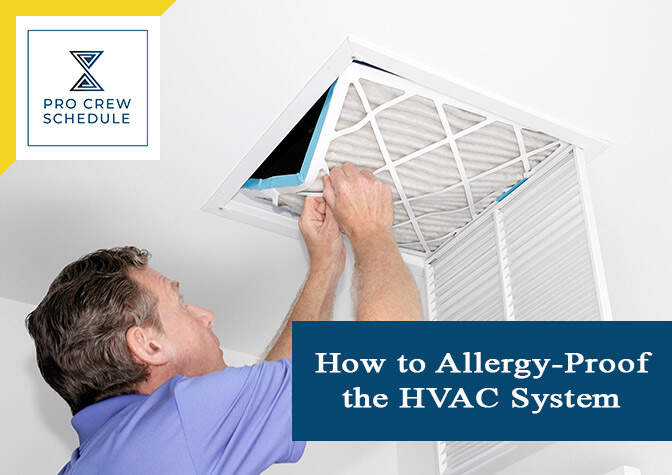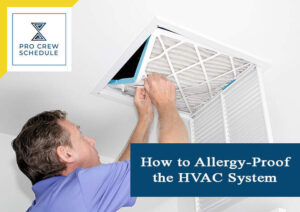Asthma and various allergies are considered a growing health problem. Allergic asthma is the most common allergy that many people experienced, affecting around 60% of people. Several substances usually found in the air can cause allergic reactions to occupants and might trigger asthma attacks. Thus, these substances should be kept under control, particularly in indoor areas. A well-designed and fully-optimized HVAC system is a great help.
In this blog, we are citing seven smart ways to effectively allergy-proof any HVAC systems.
Controlling Indoor Air-Pollution
Allergens must not be confused with irritants because it is another kind of air pollutant. The only difference is that an allergen usually affects individuals that are sensitive to it. On the other hand, irritant significantly affects everyone and will suffer from seasonal allergies. During the spring season, everyone is most likely suffers from extreme sneezing, congestion, and itchy eyes. Below some common contaminants usually found in indoor spaces:
· Pollen
· Radon gas
· Fivers from furniture fabrics and synthetic carpets
· Formaldehyde and some chemicals used for building materials
· Irritants from wood-burning fireplaces and smoking
· Volatile compounds found in pesticides, cleaning, insecticides, and personal care essentials
· Gasses from water heaters and cooking appliances
By regularly replacing indoor air with refreshing outdoor air, the ventilation system can prevent pollutant concentrations from increasing too high. Additionally, the system can be well-complemented with air purifiers to lessen pollutant concentration much further. HVAC technicians are expected to be particular in not using purifiers that have ozone. As previously mentioned, ozone is a harmful irritant.
7 Ways to Alleviate Allergies with HVAC System
A well-designed HVAC system will not only perform best but can be a helpful ally in the quest to minimize indoor allergies, making indoor space and environment much safer and cleaner. Below are the top 5 ways to reduce allergies by merely upgrading the HVAC system and its components.
1. Step-Up Filters
HVAC system recirculates the indoor air to obtain the proper temperature. Filtering, it is necessary to eliminate contaminants that can make interior system components and air quality dirty. Therefore, HEPA-style filters allow the elimination of smaller particles and debris. A HEPA-rated air filter, specifically those with a MERV rating of 10 and above, will perform best. HVAC technicians must check everything first and determine the components that need to be upgraded.
Prior to upgrading the air filters, adjustments for airflow is imperative to prevent system damage. Only qualified and experienced HVAC technicians can help determine the best HEPA filter that will meet the system needs.
2. Amp-Up the Filtration System
Electronic air filters or sometimes termed ionizers are usually incorporated directly into the HVAC system. It can aid in the elimination of airborne contaminants and allergens in indoor spaces. These special filters are electrically charged and can trap and attract smaller particles as they pass through the system. As a result, it prevents the particles from spreading to the entire space.
The American Lung Association and EPA highly recommend air filtration because it effectively eradicates contaminants living in the air. It is essential always to consider products with a MERV rating of 10+ to achieve excellent results.
3. Keep Air-Ducts Clean and Sealed
Well-cleaned air-ducts are most likely capable of distributing fresher air. Usually, HVAC technicians do regular inspections of the system parts. They usually do duct cleaning for air-ducts to ensure that this part of the system is free from hair, insects, dust, and other debris that potentially worsen any allergy symptoms.
Additionally, to understand how leaking ducts can potentially impact indoor air quality, picture out how an HVAC system works. There is a massive fan right inside the indoor units. Take note that this fan generally brings air directly into the system via the return ducts. Next, it blows conditioned air (either heated or cooled) out through the supply ducts.
4. Maintain Relative Humidity Levels properly
Having humidifiers and dehumidifiers can help maintain proper humidity levels indoors. It is essential in controlling the severity of allergy symptoms and preserving air quality at the same time. A relative humidity level of about 40% is considered the best level. Too much mildew and moisture can quickly develop. It produces spores that might worsen allergy symptoms. If there’s a little moisture, it will be easier for the smaller particles to remain airborne.
5. Control Humidity Levels
Control goes hand in hand with keeping airflow sanitary and preventing mold growth. Maintaining the airways clean, dry, and clear is an effective way to control humidity indoors. Only the filtration system can control humidity levels. HVAC technicians must choose quality products because it reflects the services they implement to their clients.
If the indoor humidity tends to increase in a building or residential space, allergies become more apparent. The moisture does not cause these allergies despite what others believed. Instead, humidity intensifies the two organisms’ growth that often produce allergies – dust mites and molds. Molds often grow invisible from plain sights and are often overlooked because it does not move. Dust mites are usually tinier to be seen by the naked eye.
6. Exterminate Microbes with UV light
HVAC technicians already determined that the indoor coil of an air conditioner stays wet 24/7. It is a common, occurring circumstance during the summer and spring season. The moist environment is suitable for microbial growth, and this is where microbes will increase AC’s indoor coils. When AC is currently running, the fans will blow bacteria and even small particles into the living space.
Getting high-quality duct leaks and air filters will prevent the coils from getting untidy. Also, microbes usually don’t grow on the coils significantly due to lesser dirt and dust to feed on.
7. Circulate fresh air
One of the essential things an HVAC technician often suggest to their clients is to allow fresh air to enter indoors. Fresh air is proven to help control odor and reduce adverse health impact. People think that to get fresh air, and they need to open windows. However, it is not the right way.
Here are the two ideal options to consider:
· Ventilating the entire house will bring fresher air. Hence, filtering and removing moisture at the same time should be continuous. Some devices often interface with the ductwork and help the air conditioners remove humidity from the air. Once you consider a fresh air intake, it will make a double effort by pushing further fresh air from the outdoors to the indoors.
· ERVs or energy recovery ventilators are very useful in removing air from home because it produces more fresh air. At the same time, it filters the air. Note that ERVs are not a dehumidifier yet can transfer humidity from the air towards the outgoing air as it cycles repeatedly.
How Beneficial Project Management Software for HVAC Technicians?
Embracing technologies and other emerging trends have helped to streamline processes and methods in the respective industry. It will increase and solidify the team’s productivity and fulfill the needs for quality HVAC installation and services. In the HVAC sector, this advanced software tool can be used for the following:
1. Real-time Communication via the cloud
Good communication is a vital element across all phases of a project. Hence, it is essential to establish a communication flow with all involved stakeholders, subcontractors, suppliers, and crew members on-site. Using this tool, it is easier to collaborate and communicate with every team quickly and efficiently.
2. Reducing Reworks and Mistakes
Mistakes and errors lead to cost reworks. Even HVAC technicians are quite aware of these complications. However, changes and abrupt insufficiencies are unavoidable, yet it can be prevented. The software tool designed for better project management can minimize reworks and prevent errors from happening all over again.
3. Scaling up Services and Operations
HVAC businesses will later on expanding, and there will be more clients availing different services. Company owners must invest in project management applications. Managing a larger team and increasing team members is easier and much efficient when this tool is used.
4. Integrating Project Data
Data and all other related information in the project are imperative as everyone involved largely relies on project details and outlined schedules. The software application is designed not just for data storage and accessibility but also for all project management purposes. The application is all in one, and it consistently proves its usability.
5. Comprehensive Timeline for Project
There should be a clear and precise timeline for any HVAC projects. HVAC contractors have to deal with a lot of project changes and updates from time to time. It is very relevant to consider a project management tool that helps them create a much clearer and functional timeline. By doing so, projects will stay on its course and within budget and will be completed at the right time.
Key Takeaways
Energy efficiency and temperature control are already given the highest priority when designing ventilation systems. On the contrary, humidity control and pollutant concentrations are sometimes overlooked. Yet, indoor air quality is likewise vital as energy efficiency, and it has an equal significance value on productivity and human health.







